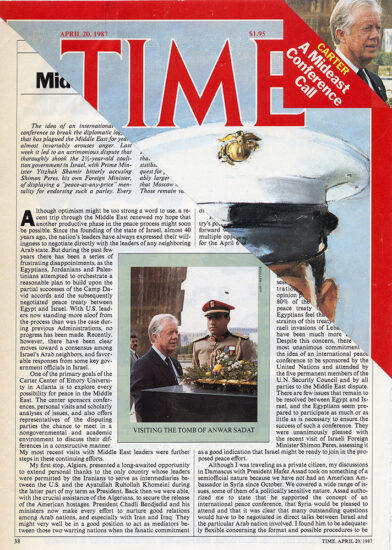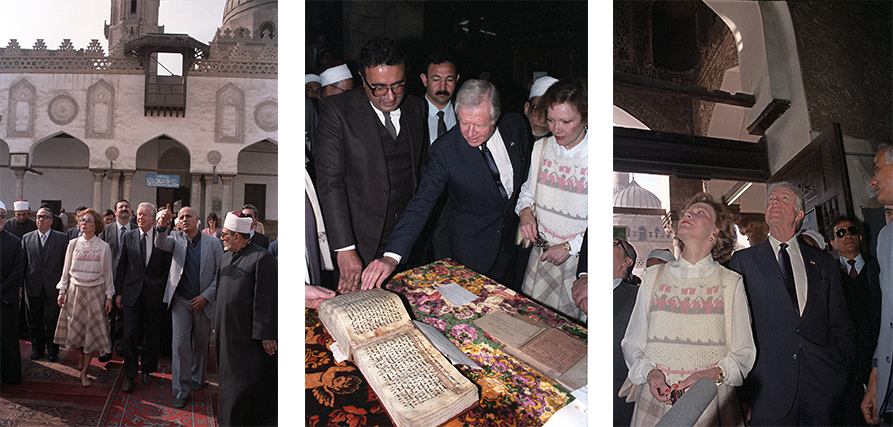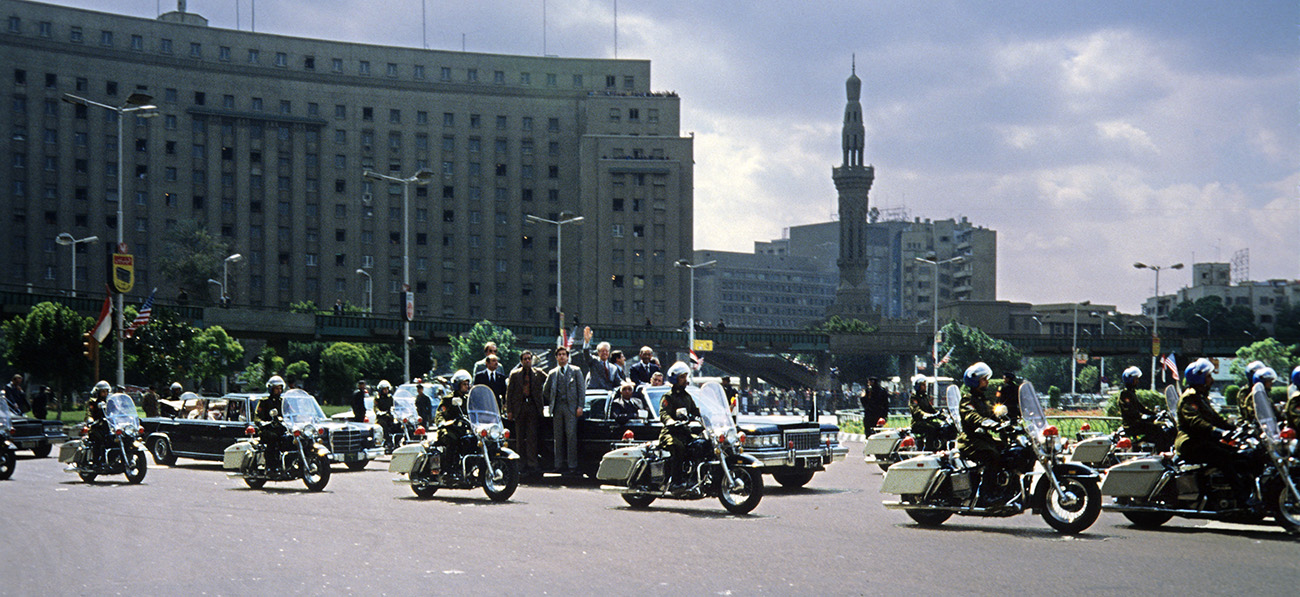Text and Photographs by Norbert Schiller
Jimmy Carter, the oldest living US president in history, is indirectly responsible for launching my journalistic career. I photographed Carter on two separate occasions in Egypt. The first time was in 1979 when I was a student traveler and novice photographer. Pursuing the president through the streets of Cairo to take a picture of his historical visit to Egypt gave me an incentive to choose journalism as a profession. The second encounter came nearly a decade later when the photo I took of Carter was widely published, confirming that I had made the right career choice.

The cover and inside page of Time Magazine that featured my photo of Jimmy Carter at the tomb of Anwar Sadat in April 1987. After seeing that published photo I realized that I had made the right career choice.
In the summer of 1978, I left the U.S. on what would become a yearlong trip traveling through Europe, North Africa, and the Middle East on a shoe-string budget. In February 1979, I arrived in Athens to prepare for my journey to the Greek archipelago. However, after a chance encounter at the hostel with two other travelers, I ended up aborting my island-hopping escapade to join my new friends on their trip to Egypt.
After a week in Egypt, my companions decided to return to Europe, while I stayed on. I had fallen in love with the country and decided to journey to Upper Egypt to explore it on my own. After a month, I returned to Cairo and found the city buzzing with excitement over Carter’s upcoming visit. The US president was in the final stages of brokering the Camp David Peace Accords between Egypt and Israel. The two countries had fought three wars since the founding of the Jewish state in 1948 and now peace seemed to be imminent. When I heard that Carter was coming the following day, I wanted to be part of this historical event. Rumor had it that Carter and Egyptian President Anwar Sadat were going to be standing in an open car as they traveled through the streets of the capital.
I was eager to capture the two heads of state together. Faris, the hostel owner, advised me to head to the presidential palace where Sadat was hosting Carter to take a picture of the motorcade. The next day, I jumped on a bus in the direction of Qubba palace located on the northern outskirts of Cairo. On the bus, I met a young Egyptian student who convinced me that the airport was a better venue for my shot. “You are an American and I’m sure that the authorities will allow you to go inside where you can take the best photo.” Being ignorant about security matters, I took the student’s advice and accompanied him to the airport.
The scene at the airport was utter mayhem. It seemed like everyone had the same idea, and throngs of people had gathered along the airport road designated for the motorcade. The airport itself was blocked off by security, and when I approached the police to ask whether I could enter the terminal as an American I was pushed back with everyone else. My companion and I tried to find a spot along the route that would be taken by the two presidents, but we couldn’t even push our way through the crowds. As Airforce One landed, the excitement became overwhelming and when the motorcade finally passed all we saw was a sea of hands waving the Egyptian and American flags.

ABC News correspondent Peter Jennings doing a standup outside Qubba Palace shortly after the arrivals of the motorcade carrying presidents Jimmy Carter and Anwar Sadat.
I was extremely upset about missing my shot and demanded that the student to take me to Qubba palace immediately. We miraculously found a taxi who raced us through back streets only to reach the palace gates as the last car in the motorcade was disappearing into the palace compound. Back at the hostel I told Faris about my misadventure. He assured me that the following day I would have another chance when Carter and Sadat planned to travel together to Majilis el Shaab, or parliament, where the US leader was scheduled to address the representatives of the Egyptian people. The motorcade would pass through Tahrir Square just two blocks away from where I was staying.

My first attempt at making the photo of the motorcade at Tahrir Square failed as the crowd surged forward blocking my view.
The next day, I headed to Tahrir Square early and found what I thought was a good spot along the route. As the time for the arrival of the motorcade got closer, people began to gather, but somehow, I managed to keep my place in the front row behind the police barricade. However, as the car transporting the two presidents approached, the spectators became agitated surging forward and blocking my view of Carter and Sadat as they passed.
By then, I had grown extremely frustrated. Still, I knew I would have one more chance to take a photo of the two leaders as they left the Majilis, so I walked around the square desperately looking for places to stand. That’s when I noticed an Egyptian police officer looking at me. I quickly walked up to him and explained that I was an American who wanted to get a photo of “my president” with Sadat. Without uttering a word, the officer walked over to a subordinate, and gave him instructions. The next thing I knew was that I was being escorted behind the police barricade into the square and told to stay put. This time I had a clear view of the motorcade and managed to take a few frames, one of which was perfectly centered and captured both Sadat and Carter, who was waving. I made that photo on my Olympus 35RD rangefinder camera with a fixed 40mm f1.7 lens. To this day, after a 40-year career as a photojournalist, I consider this to be my first newsworthy picture. More importantly, my determination and passion to get that shot made me realize that I was destined to become a press photographer.

If you don’t succeed the first time around, try again and again. After two failed attempts to photograph Jimmy Carter and Anwar Sadat in an open limousine, I asked a police officer if I could go inside the cordoned off area, and, when he obliged, I took what I consider to be my first newsworthy picture.
My next encounter with Carter came nearly a decade later, when I had made a breakthrough into the news profession and was working in Egypt as a photographer for the French news agency (AFP). Carter had already been out of office for several years, but was on a private visit to the Middle East with his wife Roselyn. He had arrived in Egypt from Algeria and was intending to visit Syria, Jordan, Israel, and Palestine. The purpose of his trip was to help stimulate the Arab-Israeli peace process, emphasizing the need to secure the rights of the Palestinian people. This was Carter’s sixth visit to the region, the third as a private citizen, as he believed that he still had unfished business to attend to. “My trip to the Middle East in the spring of 1987 provided valuable new insights into regional political dynamics.” Carter wrote after his visit, “There have been important improvements on the Arab side since my last visit to the region four years ago, especially in terms of an emerging consensus in support of an international peace conference.”

Jimmy Carter and his wife Roselyn arriving at Cairo airport in March 1987. They were met by Egyptian Minister of State for Foreign Affairs Boutros Boutros Ghali.
My assignment for AFP was to cover all aspects of the former president’s visit which was packed-full of events. It began with a protocol meeting with Minister of State for Foreign Affair Boutros Boutros Ghali who would later serve as UN Secretary General. On his second day, Carter visited Sadat’s tomb where he laid a wreath to honor the slain president. Sadat was assassinated in 1981, a few years after signing the peace deal with Israel which Carter had helped broker. Then Carter met with the head of the Coptic church Pope Shenouda before joining his wife to tour Al Azhar, Egypt’s oldest Islamic university.

Jimmy Carter at the tomb of Anwar Sadat. The former US president meets with Pope Shenouda of the Coptic church.
At al Azhar Mosque, the Carters were met by the grand Imam Gad Al Haq Ali Gad el Haq. After touring the mosque, the couple were led to a room containing ancient Korans before separating as they went on different missions. Carter had to attend to official meetings, while the first lady went shopping in the Khan al Khalili bazaar.

The Carters tour al Azhar Mosque where they visited a room that houses old Islamic manuscripts.
As is common with any high-profile visit to the bazaar, security became a nightmare. When Mrs. Carter arrived in Khan el Khalili, Egyptian secret police fanned out in the market to secure the route. The first lady visited several workshops where artisans were busy making their wares. At one point, there was some confusion among members of Mrs. Carter’s security detail who were running in and out of tourist shops. Because of the frenzy I thought there was a security threat, but the chaperon reassured me, “Mrs. Carter is looking for a shop she had visited during her last visit to Cairo.”

The Carters meet the grand Imam of al Azhar, Gad Al Haq Ali Gad el Haq, before finishing their tour of the al Azhar complex.
When nobody seemed to be able to locate the shop in question, I made a suggestion. A friend who worked at the U.S. embassy had recommended an artisan’s workshop close by. “Maybe Mrs. Carter would like to visit that shop instead,” I advised. My message was relayed to the former first lady, and suddenly I found myself leading the entire entourage through the souk. When we arrived, Mrs. Carter stepped inside and immediately recognized the shop as the place she had visited years earlier. I made a few photos of Mrs. Carter and her chaperon holding brass candle sticks, and then I headed back to the AFP office to transmit my images.

Roselyn Carter watches a craftsman in the Khan el Khalili bazar ply his trade. After finding the shop she had been looking for, Roselyn and her chaperon pose for a photo holding the brass candlesticks that the First Lady had just purchased.
The following week, after Carter had left, I learned that one of my photographs of Carter standing in front of Sadat’s tomb had made the inside pages of Time Magazine. When I went to pick up a copy of the magazine, I noticed that the same photo had also been used on the front cover. It was only the top right corner of the cover, but for me, as an aspiring photojournalist, the idea of making the cover of Time was a huge achievement. It affirmed my decision to pursue a career in photojournalism.

A great history from the real life, Norbert.
Be persistant, and you will make it 🙂
Jens Erik
He already has! Great story Norbert – hope all well with you and yours.